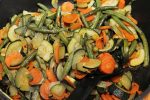Mixtures Basic Science Primary 4 Second Term Lesson Notes Week 5
Lesson Plan: Understanding Mixtures
Subject: Basic Science and Technology
Class: Primary 4
Term: Second Term
Week: Week 5
Age: 9-10 years
Topic: Mixture: Definition, Examples, and Reasons for Mixtures
Sub-topic: Understanding Mixtures and Their Importance
Duration: 40 minutes
Behavioural Objectives:
By the end of the lesson, students should be able to:
- Define a mixture and understand what it entails.
- List common examples of mixtures.
- Explain why people create mixtures.
- Discuss how mixtures are formed and their uses in daily life.
Keywords:
Mixture, substances, combination, new material, examples, cooking, gardening, science experiments, reasons for mixtures.
Set Induction:
To capture the students’ interest, the teacher will begin by asking a simple question:
“Have you ever made a drink, salad, or any combination of things to create something new? What did you mix?”
The teacher will then write the students’ responses on the board to spark discussion and transition into the lesson.
Entry Behaviour:
The students should have a basic understanding of different substances (e.g., solids, liquids, gases) and be familiar with simple objects like food and drinks that they have mixed before (e.g., lemonade, salad).
Learning Resources and Materials:
- Pictures of mixtures (e.g., salad, lemonade, paint, concrete)
- Examples of materials for mixing (e.g., water, oil, sand, salt)
- Audio-visual resources such as a video or images showing common mixtures in daily life

Building Background/Connection to Prior Knowledge:
Students should recall experiences like making lemonade, mixing flour and butter for dough, or mixing colors in art class. This knowledge will help connect the new information about mixtures to their daily lives.
Embedded Core Skills:
- Critical thinking and problem-solving: Students will analyze the mixtures they encounter and explore their purposes.
- Communication and collaboration: In group discussions, students will share ideas and listen to others.
- Creativity and imagination: Students will be encouraged to think of new mixtures or even create one in the class.
- Personal development: By exploring mixtures, students will enhance their understanding of combining materials in different contexts.
Instructional Materials:
- Pictures of mixtures (e.g., lemonade, salad)
- Samples of common mixtures (e.g., saltwater, trail mix)
- A video showing the preparation of mixtures in cooking, art, and science
Content:
Mixture: Definition, Examples, and Reasons for Mixtures
- Definition of Mixture:
A mixture is when two or more substances are combined together, but they don’t change chemically. They can be separated easily by physical methods like filtering or sorting.Example:- Lemonade: Mixing water, sugar, and lemon juice to make a refreshing drink.
- Salad: A mixture of vegetables like lettuce, tomatoes, and cucumbers.
- Trail Mix: A combination of nuts, seeds, and dried fruits.
- Examples of Mixtures:
- Concrete: A mixture of cement, sand, and gravel used in construction.
- Air: A mixture of gases like nitrogen, oxygen, and carbon dioxide.
- Saltwater: A mixture of salt and water.
- Paint: A mixture of pigment, binder, and solvent.
- Soup: A mixture of vegetables, meat, and broth.
- Reasons for Making Mixtures:
- To create something new and exciting: Mixing colors in art can create a new color.
- To improve something: Adding sugar to lemon juice makes lemonade taste better.
- To achieve a specific function: Gasoline is a mixture that powers vehicles.
- For scientific exploration: Mixing chemicals in a lab to explore reactions.
- To meet industry needs: Concrete is used for building structures.
- To improve nutritional value: Breakfast cereals often mix grains for better nutrition.
- Things that can be mixed
- Here are some more examples of mixtures:
Lemonade: Lemonade is made by mixing water, sugar, and lemon juice together.
Salad: A salad is a mixture of different vegetables like lettuce, tomatoes, and cucumbers.
Trail mix: Trail mix is a mixture of different foods like nuts, seeds, and dried fruit.
- Here are some more examples of mixtures:
Evaluation:
- What is a mixture?
a) When you take two or more things and mix them together to make something new
b) When you take two or more things and keep them separate
c) When you take one thing and break it into smaller pieces - Which of the following is an example of a mixture?
a) A glass of water
b) A piece of bread
c) Trail mix - What is an example of a mixture that is used in cooking?
a) Lemonade
b) Soup
c) Cement - What happens when you mix red and blue paint together?
a) You get purple
b) You get green
c) You get orange - Which of the following is a mixture of gases?
a) Water
b) Air
c) Salt
Class Activity Discussion:
15 FAQs with Answers to Help Students Better Understand the Topic:
- What is a mixture?
- A mixture is when two or more things are combined, but they don’t change chemically.
- Can you name a mixture you’ve seen at home?
- Examples might be salad, lemonade, or a cup of coffee with milk.
- What makes a mixture different from a solution?
- In a mixture, the substances can still be separated, while in a solution, they cannot.
- Is air a mixture?
- Yes, air is a mixture of gases like oxygen, nitrogen, and carbon dioxide.
- Why do we mix things like flour and butter?
- To create dough, which is used in baking.
- Can you separate the ingredients of a mixture?
- Yes, using methods like filtration, sorting, or evaporation.
- What happens when we mix salt and water?
- We create saltwater, which is a mixture used for various purposes.
- Can mixtures be harmful?
- Mixtures themselves are not harmful, but improper mixtures like chemicals can be dangerous.
- Can mixtures be made for fun?
- Yes, like mixing colors in art or ingredients in cooking.
- Are there mixtures in nature?
- Yes, like soil (a mixture of sand, clay, and organic material).
- Why is concrete a mixture?
- Concrete is a mixture of cement, sand, and gravel that is used for construction.
- Is lemonade a mixture?
- Yes, lemonade is made by mixing water, lemon juice, and sugar.
- Can mixtures change over time?
- Yes, some mixtures like salad or soup might change as the ingredients blend together over time.
- How are mixtures useful in science?
- Scientists mix chemicals to observe reactions and create new substances.
- Can we create mixtures to preserve food?
- Yes, like saltwater used for preserving fish or meat.
Teacher’s Activities:
- The teacher introduces the lesson by asking students what they know about mixtures.
- The teacher defines a mixture and uses visual aids to show common mixtures.
- The teacher engages students in brainstorming examples of mixtures they know.
- The teacher explains why people make mixtures, providing relevant examples.
- The teacher concludes by asking students to summarize what they’ve learned.
Learners’ Activities:
- Students will participate in class discussions, sharing examples of mixtures.
- In small groups, they will brainstorm additional examples of mixtures.
- Students will answer evaluation questions and participate in class activities like mixing substances to create new things.
Evaluation Questions:
- What is a mixture?
- Can you give an example of a mixture used in cooking?
- What happens when you mix red and blue paint?
- Why do people create mixtures?
- What is an example of a mixture used in science experiments?
- How can mixtures be separated?
- What is an example of a mixture used in construction?
- Name a mixture that is used in personal care products.
- Is air a mixture?
- What happens when you mix salt and water?
Conclusion:
The teacher summarizes key points:
- Mixtures are made up of two or more substances combined without chemically changing.
- Examples include lemonade, concrete, and trail mix.
- Mixtures are useful for creating new things, improving products, or serving specific functions.
The teacher will assess students’ understanding by marking their answers and providing feedback.
SEO Title: Understanding Mixtures: Definition, Examples, and Reasons
Focus Keyphrase: Mixtures in Science
Slug: mixtures-definition-examples-reasons
Meta Description: Learn about mixtures, their definition, common examples, and why people make mixtures. Ideal for Primary 4 students to understand mixtures in everyday life.
Weekly Assessment /Test
- A mixture is made up of two or more substances that are combined but not ____________ joined together.
- People create mixtures for many different reasons, such as to create something new and ____________, to improve something, or to achieve a specific function.
- An example of a mixture used in cooking is a salad, which is a mixture of different ____________.
- Adding sugar to lemon juice makes it taste better, which is an example of using a mixture to ____________ something.
- Concrete is a mixture of cement, sand, and ____________ that is used in construction projects.
- Saltwater is a mixture that can be used to ____________ food.
- Gasoline is a mixture of different ____________ that is designed to power vehicles and machinery.
- Paint is a mixture of pigment, binder, and ____________.
- Trail mix is a mixture of nuts, seeds, and dried ____________.
- Mixing different chemicals together can create new ____________ and reactions in science experiments.
